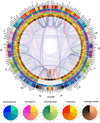Circular representation of human cortical networks for subject and population-level connectomic visualization
- PMID: 22305988
- PMCID: PMC3594415
- DOI: 10.1016/j.neuroimage.2012.01.107
Circular representation of human cortical networks for subject and population-level connectomic visualization
Abstract
Cortical network architecture has predominantly been investigated visually using graph theory representations. In the context of human connectomics, such representations are not however always satisfactory because canonical methods for vertex-edge relationship representation do not always offer optimal insight regarding functional and structural neural connectivity. This article introduces an innovative framework for the depiction of human connectomics by employing a circular visualization method which is highly suitable to the exploration of central nervous system architecture. This type of representation, which we name a 'connectogram', has the capability of classifying neuroconnectivity relationships intuitively and elegantly. A multimodal protocol for MRI/DTI neuroimaging data acquisition is here combined with automatic image segmentation to (1) extract cortical and non-cortical anatomical structures, (2) calculate associated volumetrics and morphometrics, and (3) determine patient-specific connectivity profiles to generate subject-level and population-level connectograms. The scalability of our approach is demonstrated for a population of 50 adults. Two essential advantages of the connectogram are (1) the enormous potential for mapping and analyzing the human connectome, and (2) the unconstrained ability to expand and extend this analysis framework to the investigation of clinical populations and animal models.
Published by Elsevier Inc.
Conflict of interest statement
None of the authors has a conflict of interest to disclose.
Figures




References
-
- Bassett DS, Brown JA, Deshpande V, Carlson JM, Grafton ST. Conserved and variable architecture of human white matter connectivity. Neuroimage. 2011;54:1262–1279. - PubMed
-
- Blondel VD, Guillaume J-L, Lambiotte R, Lefebvre E. Fast unfolding of communities in large networks. J. Stat. Mech.: Theory Exp. 2008 P10008.
-
- Brandes U. A faster algorithm for betweenness centrality. Journal of Mathematical Sociology. 2001;25:163–177.
-
- Bullmore E, Sporns O. Complex brain networks: graph theoretical analysis of structural and functional systems. Nat. Rev. Neurosci. 2009;10:186–198. - PubMed
Publication types
MeSH terms
Grants and funding
LinkOut - more resources
Full Text Sources
Medical

